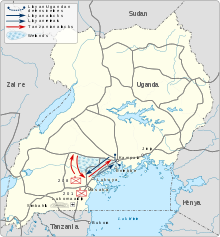Portal:Tanzania
 The Tanzania Portal
Tanzania, officially the United Republic of Tanzania, is a country in East Africa within the African Great Lakes region. It is bordered by Uganda to the northwest; Kenya to the northeast; the Indian Ocean to the east; Mozambique and Malawi to the south; Zambia to the southwest; and Rwanda, Burundi, and the Democratic Republic of the Congo to the west. Mount Kilimanjaro, Africa's highest mountain, is in northeastern Tanzania. According to the 2022 national census, Tanzania has a population of nearly 62 million, making it the most populous country located entirely south of the equator. Many important hominid fossils have been found in Tanzania, such as 6-million-year-old Pliocene hominid fossils. In the Stone and Bronze Age, prehistoric migrations into Tanzania included Southern Cushitic speakers who moved south from present-day Ethiopia; Eastern Cushitic people who moved into Tanzania from north of Lake Turkana about 2,000 and 4,000 years ago; and the Southern Nilotes, including the Datoog, who originated from the present-day South Sudan–Ethiopia border region between 2,900 and 2,400 years ago. These movements took place at about the same time as the settlement of the Mashariki Bantu from West Africa in the Lake Victoria and Lake Tanganyika areas. In the late 19th century, the mainland came under German rule as German East Africa, and this was followed by British rule after World War I when it was governed as Tanganyika, with the Zanzibar Archipelago remaining a separate colonial jurisdiction. Following their respective independence in 1961 and 1963, the two entities merged in 1964 to form the United Republic of Tanzania. Tanganyika joined the British Commonwealth and Tanzania remains a member of the Commonwealth as a unified republic. Tanzania is mountainous and densely forested in the north-east, where Mount Kilimanjaro, the highest mountain in Africa and the highest single free-standing mountain above sea level in the world, is located. Three of Africa's Great Lakes are partly within Tanzania. To the north and west lie Lake Victoria, Africa's largest lake, and Lake Tanganyika, the continent's deepest lake, known for its unique species of fish. To the south lies Lake Malawi. The eastern shore is hot and humid, with the Zanzibar Archipelago just offshore. The Menai Bay Conservation Area is Zanzibar's largest marine protected area. The Kalambo Falls, located on the Kalambo River at the Zambian border, is the second-highest uninterrupted waterfall in Africa. Tanzania is one of the most visited tourist destinations for safaris. Selected article -People have lived in Zanzibar for 20,000 years. The earliest written accounts of Zanzibar began when the islands became a base for traders voyaging between the African Great Lakes, the Somali Peninsula, the Arabian peninsula, Iran, and the Indian subcontinent. Unguja offered a protected and defensible harbour, so although the archipelago had few products of value, Omanis and Yemenis settled in what became Zanzibar City (Stone Town) as a convenient point from which to trade with towns on the Swahili Coast. They established garrisons on the islands and built the first mosques in the African Great Lakes Region. During the Age of Exploration, the Portuguese Empire was the first European power to gain control of Zanzibar, and kept it for nearly 200 years. In 1698, Zanzibar fell under the control of the Sultanate of Oman, which developed an economy of trade and cash crops, with a ruling Arab elite and a Bantu general population. Plantations were developed to grow spices; hence, the moniker of the Spice Islands (a name also used for the Dutch colony the Moluccas, now part of Indonesia). Another major trade good was ivory, the tusks of elephants that were killed on the Tanganyika mainland - a practice that is still in place to this day. The third pillar of the economy was slaves, which gave the Zanzibar slave trade an important place in the Indian Ocean slave trade, the Indian Ocean equivalent of the better-known Triangular Trade. The Omani Sultan of Zanzibar controlled a substantial portion of the African Great Lakes coast, known as Zanj, as well as extensive inland trading routes. (Full article...)General images -The following are images from various Tanzania-related articles on Wikipedia.
This month in Tanzanian history
Wildlife of Tanzania - Credit: P1050483
The Olive Baboon (Papio anubis), also called the Anubis Baboon, is a member of the family Cercopithecidae (Old World monkeys). The species is the most widely spread of all baboons: it is found in 25 countries throughout Africa, extending south from Mali to Ethiopia and to Tanzania. Isolated populations are also found in some mountainous regions of the Sahara. It inhabits savannahs, steppes, and forest areas. Did you know ...
CategoriesWikiProjectsRecognised contentSelected panorama -Skyline of the Dar es Salaam city center.
Uganda–Tanzania War -Articles here focus upon aspects of the Uganda–Tanzania War. These are all Good articles that meet a core set of high editorial standards.
The Battle of Lukaya (Kiswahili: Mapigano ya Lukaya) was a battle of the Uganda–Tanzania War. It was fought on 10 and 11 March 1979 around Lukaya, Uganda, between Tanzanian forces (supported by Ugandan rebels) and Ugandan government forces (supported by Libyan and Palestinian troops). After briefly occupying the town, Tanzanian troops and Ugandan rebels retreated under artillery fire. The Tanzanians subsequently launched a counterattack, retaking Lukaya and killing hundreds of Libyans and Ugandans. President Idi Amin of Uganda attempted to invade neighbouring Tanzania to the south in 1978. The attack was repulsed, and Tanzania launched a counterattack into Ugandan territory. In February 1979, the Tanzania People's Defence Force (TPDF) seized Masaka. The TPDF's 201st Brigade was then instructed to secure Lukaya and its causeway to the north, which served as the only direct route through a large swamp to Kampala, the Ugandan capital. Meanwhile, Amin ordered his forces to recapture Masaka, and a force was assembled for the purpose consisting of Ugandan troops, allied Libyan soldiers, and a handful of Palestine Liberation Organisation guerrillas, led by Lieutenant Colonel Godwin Sule. (Full article...)TopicsSelected picture - Credit: Winky
Dhow off the coast of Zanzibar at sunset. Dhows are traditional Arab sailing boats used primarily along the coasts of the Arabian Peninsula, India, and East Africa. ...Archive — Nominations
Related portalsThings you can doAssociated WikimediaThe following Wikimedia Foundation sister projects provide more on this subject:
Discover Wikipedia using portals | ||||









































































